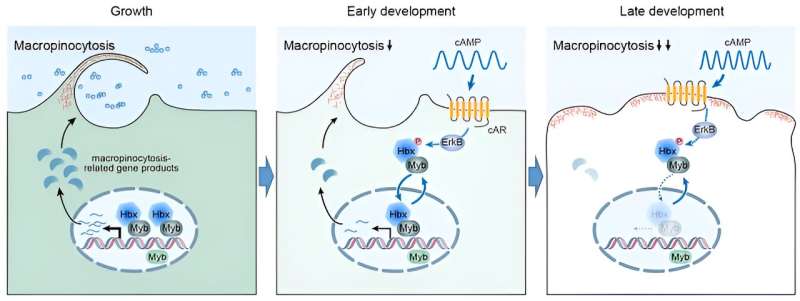This article has been reviewed according to Science X's editorial process and policies. Editors have highlighted the following attributes while ensuring the content's credibility:
fact-checked
trusted source
proofread
Researchers discover how cells modulate macropinocytic activity

Macropinocytosis is one of the major pathways by which cells non-selectively internalize extracellular fluids. The laboratory strain Dictyostelium discoideum serves as a valuable model for studying the regulation of macropinocytosis.
This model cell is a social amoeba that exists as a single cell when nutrients are abundant and uses macropinocytosis to acquire nutrients. Under conditions of nutrient deprivation, it enters a developmental stage and undergoes directed migration to form multicellular structures. The molecular mechanisms behind this transition from macropinocytosis to migration mode are still unclear.
In a study published in Developmental Cell on Feb. 6, researchers led by Prof. Cai Huaqing from the Institute of Biophysics of the Chinese Academy of Sciences, together with Prof. Li Lei from Peking University, revealed the molecular mechanisms by which cells regulate the level of macropinocytosis in response to nutrient stress.
Through forward genetic screening and mass spectrometry, the researchers first identified two transcription factors, Hbx5 and MybG, that are involved in macropinocytosis.
Using microscopy, biochemical experiments, RNA-Seq, and ChIP-Seq, the researchers found that Hbx5 and MybG form a heterodimeric complex. During the nutrient growth phase, this complex localizes to the cell nucleus and regulates the expression of genes involved in macropinocytosis, maintaining high levels of macropinocytosis.
Under nutrient stress, oscillatory cAMP signaling causes the Hbx5-MybG complex to undergo nucleocytoplasmic shuttling, resulting in the downregulation of genes involved in macropinocytosis. As the frequency of cAMP oscillatory signaling increases during the development, the Hbx5-MybG complex ceases shuttling and becomes trapped in the cytoplasm, turning off the expression of genes that promote macropinocytosis and facilitating the transition to directed migration behavior.
This study has identified key regulatory components that enable cells to maintain macropinocytosis and modulate its level in response to nutrient stress. It not only provides new insights into the molecular mechanisms by which cells regulate macropinocytosis in response to environmental changes but also opens up new avenues for studying the decoding mechanisms of oscillatory signaling in cells.
More information: Yazhou Hao et al, A transcription factor complex in Dictyostelium enables adaptive changes in macropinocytosis during the growth-to-development transition, Developmental Cell (2024). DOI: 10.1016/j.devcel.2024.01.012
Provided by Chinese Academy of Sciences




















